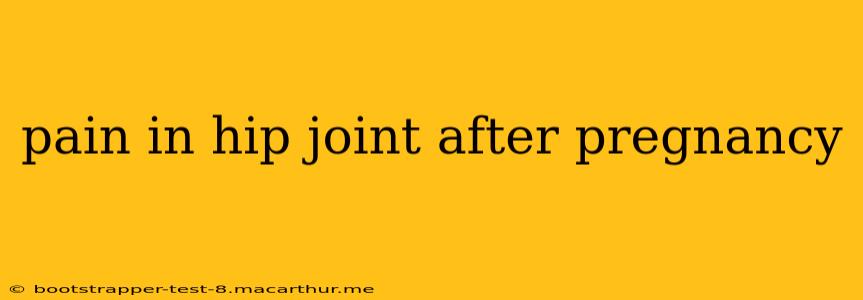Pregnancy and childbirth place immense strain on a woman's body, and hip pain is a common complaint in the postpartum period. This isn't just fleeting discomfort; it can significantly impact a new mother's ability to care for herself and her baby. This comprehensive guide delves into the causes, treatment options, and preventative measures for hip pain after pregnancy. We'll explore the various factors contributing to this issue and offer practical advice for managing and alleviating the pain.
What Causes Hip Pain After Pregnancy?
Several factors contribute to hip pain after pregnancy. Hormonal changes, weight gain, and the physical demands of carrying a baby and caring for a newborn all play a role. Let's explore some key causes:
-
Relaxin Hormone: During pregnancy, the body produces relaxin, a hormone that softens ligaments and cartilage to prepare the pelvis for childbirth. While beneficial for delivery, this increased laxity can lead to instability in the hip joints, making them more susceptible to pain and injury.
-
Weight Gain: The average weight gain during pregnancy is substantial. This added weight puts extra pressure on the hips, knees, and ankles, contributing to pain and discomfort.
-
Postural Changes: As the pregnancy progresses, women often experience postural changes to accommodate the growing belly. This can lead to an altered center of gravity, putting additional stress on the hip joints and surrounding muscles.
-
Muscle Weakness: Pregnancy can weaken abdominal and pelvic floor muscles. These muscles play a crucial role in supporting the hip joints, and their weakness can exacerbate hip pain.
-
Symphysis Pubis Dysfunction (SPD): This condition involves pain in the pubic symphysis, the joint connecting the two pubic bones. While primarily affecting the pubic area, SPD can radiate pain to the hips and groin.
-
Sacroiliac (SI) Joint Dysfunction: Similar to SPD, SI joint dysfunction involves pain in the sacroiliac joints, which connect the sacrum (the triangular bone at the base of the spine) to the pelvis. This can also cause radiating hip pain.
How is Hip Pain After Pregnancy Diagnosed?
A healthcare professional, typically a doctor or physical therapist, will diagnose hip pain after pregnancy. This usually involves:
-
Physical Examination: The doctor will assess your range of motion, palpate the hip joint and surrounding areas for tenderness, and observe your gait (walking pattern).
-
Medical History: A detailed medical history, including your pregnancy and delivery experience, will be taken.
-
Imaging Tests (if necessary): In some cases, imaging tests like X-rays or MRI scans may be used to rule out other conditions, such as fractures or arthritis.
What are the Treatment Options for Hip Pain After Pregnancy?
Treatment options for postpartum hip pain vary depending on the severity and underlying cause. Common approaches include:
-
Rest and Ice: Resting the affected hip and applying ice packs can help reduce inflammation and pain.
-
Over-the-Counter Pain Relief: Nonsteroidal anti-inflammatory drugs (NSAIDs) like ibuprofen can help manage pain and inflammation. Always consult your doctor before taking any medication, especially while breastfeeding.
-
Physical Therapy: Physical therapy is often recommended to strengthen weakened muscles, improve flexibility, and correct postural imbalances. Exercises may include stretches, strengthening exercises, and pelvic floor exercises.
-
Manual Therapy: Techniques like chiropractic adjustments or osteopathic manipulation may help restore joint mobility and reduce pain.
-
Other Therapies: In some cases, other therapies, such as acupuncture or massage therapy, may provide additional pain relief.
How Can I Prevent Hip Pain After Pregnancy?
Prevention is key. While some factors are unavoidable, proactive measures can significantly reduce the risk of hip pain after pregnancy:
-
Maintain a Healthy Weight: Avoid excessive weight gain during pregnancy by following a balanced diet and engaging in regular exercise.
-
Regular Exercise: Engage in moderate-intensity exercise throughout your pregnancy (with your doctor's approval). This helps maintain muscle strength and flexibility. Focus on exercises that strengthen core and pelvic floor muscles.
-
Good Posture: Maintain good posture throughout your pregnancy and postpartum period.
-
Pelvic Floor Exercises: Start pelvic floor exercises during pregnancy and continue them postpartum to strengthen the pelvic floor muscles.
-
Postnatal Support: Wear a postpartum support belt to provide extra support to the abdominal and pelvic area.
What Exercises Can Help With Hip Pain After Pregnancy?
Specific exercises are best prescribed by a physical therapist tailored to your individual needs and condition. However, some general exercises that may help include:
-
Hip Flexor Stretches: Gently stretching the hip flexors can alleviate tightness and improve mobility.
-
Glute Strengthening Exercises: Strengthening the gluteal muscles helps stabilize the hip joint.
-
Pelvic Tilts: Pelvic tilts can strengthen the abdominal and back muscles, improving core stability.
-
Side-Lying Hip Abduction: This exercise strengthens the muscles that abduct (move away from the midline) the hip.
When Should I See a Doctor About Hip Pain After Pregnancy?
You should consult your doctor if your hip pain:
- Is severe or persistent.
- Is accompanied by other symptoms such as fever, swelling, or redness.
- Limits your ability to care for yourself or your baby.
- Doesn't improve with home remedies.
Remember, this information is for general knowledge and should not replace professional medical advice. Always consult your doctor or a qualified healthcare professional for diagnosis and treatment of hip pain after pregnancy. They can assess your specific situation and recommend the most appropriate course of action.
